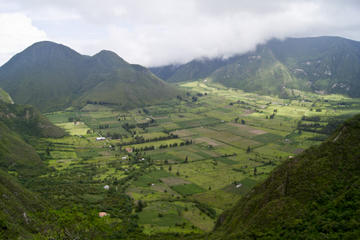Pululahua
TIME : 2016/2/22 10:39:25

Pululahua
Only two craters in the world are inhabited—and Pululahua is one of them. Essentially a fog-filled, fertile bowl set 9,000 feet in the sky, Pululahua is the only crater in the world that’s also actively farmed. Though the area rarely ever receives rain, the rolling fog provides ample moisture for raising fields full of crops. Most people who visit, however, only make it as far as the overlooks, which are dotted along the crater rim and offer sweeping views of the basin. Those with a little more time, however, and a healthy dose of adventure, can hike, bike, or horseback ride the trails to the crater floor. Once here, walk amongst a rural setting that feels like it’s frozen in time. Gone are the urban trappings of Quito and the incessant hum of cars, which are replaced by the sounds of smiling farmers who still work the ground by hand. Aside from the trails, farmers, and fog, Pululahua is famously known for its ecological wealth. The crater is a geobotanical reserve with over 2,000 species of plants, and was the first place in South America preserved as a National Park. It’s even possible to sleep in the crater in simple, traditional hostels, and even if you can only spend 30 minutes admiring the view from the rim, this spot the Inca dubbed “cloud of water” is a site you’ll never forget.
Practical Info
Pululahua Crater is approximately 30 minutes from the streets of downtown Quito. The crater is accessible by bus or cab, as well as a number of guided tours that visit multiple sites in the area. For travel by bus, catch the bus to Mitad del Mundo and hire a taxi from there. Views of the crater are best in the morning before the clouds roll in, and remember to pace yourself when hiking to account for the high elevation.
